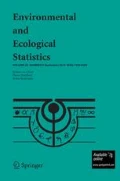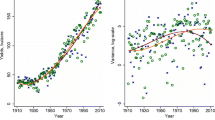Abstract
Historically, the National Agricultural Statistics Service crop forecasts and estimates have been determined by a group of commodity experts called the Agricultural Statistics Board (ASB). The corn yield forecasts for the “speculative region,” ten states that account for approximately 85 % of corn production, are based on two sets of monthly surveys, a farmer interview survey and a field measurement survey. The members of the ASB subjectively determine a forecast on the basis of a discussion of the survey data and auxiliary information about weather, average planting dates, and crop maturity. The ASB uses an iterative procedure, where initial state estimates are adjusted so that the weighted sum of the final state estimates is equal to a previously-determined estimate for the speculative region. Deficiencies of the highly subjective ASB process are lack of reproducibility and a measure of uncertainty. This paper describes the use of Bayesian methods to model the ASB process in a way that leads to objective forecasts and estimates of the corn yield. First, we use small area estimation techniques to obtain state-level forecasts. Second, we describe a way to adjust the state forecasts so that the weighted sum of the state forecasts is equal to a previously-determined regional forecast. We use several diagnostic techniques to assess the goodness of fit of various models and their competitors. We use Markov chain Monte Carlo methods to fit the models to both historic and current data from the two monthly surveys. Our results show that our methodology can provide reasonable and objective forecasts of corn yields for states in the speculative region.



Similar content being viewed by others
References
Banerjee S, Carlin B, Gelfand A (2004) Hierarchical modeling and analysis for spatial data. Chapman & Hall CRC, London
Battese GE, Harter RM, Fuller WA (1988) An error-components model for prediction of county crop areas using survey and satellite data. J Am Stat Assoc 83:28–36
Berg E, Barboza W, Nandram B (2011) A constrained Bayesian hierarchical model for forecasting state-level corn yield. Unpublished NASS technical report
Datta G, Ghosh M, Steorts R, Maples J (2011) Bayesian benchmarking with applications to small area estimation. TEST 20:574–588
Fay R, Herriot R (1979) Estimates of income for small places: an application of James–Stein procedures to census data. J Am Stat Assoc 74:341–353
Gelfand AE, Ghosh SK (1998) Model choice: a minimum posterior predictive loss approach. Biometrika 85:1–11
Irwin S, Good D, Tannura M (2008) Weather, technology, and corn and soybean yields in the U.S. corn belt. Forming expectations about 2008 U.S. corn and soybean yields application of crop weather models that incorporate planting progress. Marketing and outlook briefs. Department of Agricultural and Consumer Economics, University of Illinois at Urbana-Champaign
Kass RE, Steffey D (1989) Approximate Bayesian inference in conditionally independent hierarchical models (parametric empirical Bayes models). J Am Stat Assoc 84(407):717–726
Kantanantha N, Serban N, Griffin P (2010) Yield and price forecasting for stochastic crop decision planning. J Agric Biol Environ Stat 15(3):362–380
Keller T, Olkin I (2002) Combining correlated unbiased estimators of the mean of a normal distribution. Technical Report No. 2002–5. National Agricultural Statistics Service
Keller T, Wigton W, Garber S, McEwen B, Rumberg D, Schleusener M, DeWalt D, Ellison H, Onig L, Jantzi D, Thessen G, Guss P, Parks B (2004) Research on composite indications of crop yield. Technical Report. National Agricultural Statistics Service
Manzi G, Spiegelhalter DJ, Turner RM, Flowers F, Thompson SG (2011) Modelling bias in combining small area prevalence from multiple surveys. J R Stat Soc A 174:31–50
Nandram B, Sayit H (2011) A Bayesian analysis of small area probabilities under a constraint. Surv Methodol 37:137–152
Raghunathan TE, Xie D, Schenker N, Parsons VL, Davis WW, Dodd KW, Feuer EJ (2007) Combining information from two surveys to estimate county-level prevalence rates of cancer risk factors and screening. J Am Stat Assoc 102:474–486
Roper A, Wagstaff KL (2007) A Support-vector based machine Learning Approach to prediction of crop yield from multispectral satellite images. J Mach Learn Res 1:1–48
Rosenzweig C, Tubiello FN, Goldberg R, Mills E, Bloomfield J (2002) Increased crop damage in the US from excess precipitation uncer climate change. Glob Environ Change 12:197–202
Spiegelhalter DJ, Best NG, Carlin BP, Van der Linde A (2002) Bayesian measures of model complexity and fit. J R Stat Soc B 64:583–630
Tannura MA, Irwin SH, Good DL (2008) Weather, technology, and corn and soybean yields in the U.S. corn belt. Marketing and outlook research report 2008–01. Department of Agricultural and Consumer Economics, University of Illinois at Urbana-Champaign
Vado L, Goodwin B (2010) Analyzing the effects of weather and biotechnology adoption on corn yields and crop insurance performance in the U.S. corn belt. Selected Paper prepared for presentation at the Agricultural and Applied Economics Association’s 2010 AAEA, CAES and WAEA Joint Annual Meeting, Denver, CO., July 25–27, 2010
Wang JC, Holan SH, Nandram B, Barboza W, Toto C, Anderson EA (2010) Internal NASS Report
Wang JC, Holan SH, Nandram B, Barboza W, Toto C, Anderson EA (2011) Bayesian approach to estimating agricultural yield based on multiple repeated surveys. J Agric Biol Environ Stat 1085–7117:1–23. doi:10.1007/s13253-011-0067-5
Acknowledgments
The authors thank Jay Wang for allowing us to use the R code which was developed in the collaborative project of the National Institute for Statistical Sciences (NISS) and the National Agricultural Statistics Service (NASS) for predicting corn yields.
Author information
Authors and Affiliations
Corresponding author
Additional information
Handling Editor: Ashis SenGupta.
Appendix: full conditionals for Metropolis-Hastings
Appendix: full conditionals for Metropolis-Hastings
Notation used in this section: \(\varvec{1}_{d}\) is a \(d\)—dimensional column vector of ones, \(\varvec{I}_{d}\) is a \(d\)—dimensional identity matrix, \(\varvec{\varOmega }\) denotes the vector of parameters excluding the parameter being generated, and \(\varvec{Z}\) is the matrix with rows \(\varvec{z}_{t\ell }^{\prime }\) listed in the order with states grouped together.
1.1 Unconstrained state model
Looking at the joint posterior density in (5), we can obtain the conditional posterior densities (CPD) to run the Metropolis-Hastings sampler.
-
For state\(\times \)year combinations where data from all surveys are available, the conditional posterior distribution (CPD) of \(\mu _{t\ell }\,|\,\varvec{\varOmega } \) is
$$\begin{aligned} \mu _{t\ell }\,|\,\varvec{\varOmega } \sim \hbox {N}(\varDelta _{1,t\ell }^{-1}\varDelta _{2,t\ell }, \varDelta _{1,t\ell }^{-1}), \end{aligned}$$where
$$\begin{aligned} \varDelta _{1,t\ell }&= [\varvec{1}_{5}^{\prime }(\varvec{\varSigma }_{O} + \varvec{S}_{t\ell O})^{-1}\varvec{1}_{5}\nonumber \\&\quad +\, \varvec{1}_{4}^{\prime }(\varvec{\varSigma }_{A} + \varvec{S}_{t\ell A})^{-1}\varvec{1}_{4} + 1/S^{2}_{Dt\ell } + 1/\sigma ^{2}_{\eta }],\end{aligned}$$(10)$$\begin{aligned} \varDelta _{2,t\ell }&= \varvec{1}_{5}^{\prime }(\varvec{\varSigma }_{O}+\varvec{S}_{t\ell O})^{-1}(\varvec{Y}_{t\ell O} - \varvec{b}_{O})\nonumber \\&\quad +\, \varvec{1}_{4}^{\prime }(\varvec{\varSigma }_{A}+ \varvec{S}_{t\ell A})^{-1}(\varvec{Y}_{t\ell A} - \varvec{b}_{A}) + S^{-2}_{Dt\ell }Y_{Dt\ell } + \varvec{z}_{t\ell }^{\prime }\varvec{\beta }/\sigma ^{2}_{\eta }. \end{aligned}$$(11)For combinations of states and years where at least one survey indication is not available, the terms in \(\varDelta _{1,t\ell }\) and \(\varDelta _{2,t\ell }\) associated with the missing survey indications are omitted.
-
The CPD of \(\varvec{b}_{k} \,|\,\varvec{\varOmega }\) is \(\varvec{b}_{k} \,|\,\varvec{\varOmega } \sim \hbox {N}(\varvec{\varDelta }_{1,k}^{-1}\varvec{\varDelta }_{2,k}, \varvec{\varDelta }_{1,k}^{-1})\), where
$$\begin{aligned} \varvec{\varDelta }_{1,k}&= \sum _{\ell =1}^{L}\sum _{t=s(\ell , k)}^{T} (\varvec{\varSigma }_{k} + \varvec{S}_{t\ell k})^{-1} + 10^{-6}\varvec{I}_{M(k)},\\ \varvec{\varDelta }_{2,k}&= \sum _{\ell =1}^{L}\sum _{t=s(\ell , k)}^{T} (\varvec{\varSigma }_{k} + \varvec{S}_{t\ell k})^{-1}(\varvec{Y}_{t\ell k} - \varvec{1}_{M(k)}\mu _{t\ell }). \end{aligned}$$ -
Letting \(p\) denote the number of covariates including the intercept, the CPD of \(\varvec{\beta }\,|\,\varvec{\varOmega }\) is \(\varvec{\beta }\,|\,\varvec{\varOmega } \sim \hbox {N}(\varvec{\varDelta }_{1}^{-1}\varvec{\varDelta }_{2}, \varvec{\varDelta }_{1}^{-1})\), where
$$\begin{aligned} \varvec{\varDelta }_{1} = \varvec{Z}^{\prime }\varvec{Z}/\sigma ^{2}_{\eta } + 10^{-6}\varvec{I}_{p}, \varvec{\varDelta }_{2} = \varvec{Z}^{\prime }\varvec{\mu }/\sigma ^{2}_{\eta }. \end{aligned}$$ -
The CPD of \(\sigma ^{2}_{\eta }\,|\,\varvec{\varOmega }\) is \(\sigma ^{2}_{\eta }\,|\,\varvec{\varOmega } \sim \hbox {Inverse-gamma}(a, b)\), where
$$\begin{aligned} a = 0.001 + 0.5\sum _{t=1}^{T}L(t), b = 0.001 + \sum _{t = 1}^{T} \sum _{\ell =1}^{L(t)}0.5(\varvec{z}_{t\ell }^{\prime }\varvec{\beta } - \mu _{t\ell })^{2}. \end{aligned}$$ -
The CPD of \(\sigma ^{2}_{km}\) and \(\rho _{k}\) are not proportional to known distributions, so we use Metropolis-Hastings with the vector of transformed variables,
$$\begin{aligned} \varvec{\gamma } = (\varvec{\gamma }_{1}^{\prime },\varvec{\gamma }_{2}^{\prime })^{\prime }, \end{aligned}$$
where
and
The proposal distribution is a multivariate normal distribution with a fixed covariance matrix and mean equal to the current value.
1.2 Constrained state model
For the constrained state model, \(\mu _{tL(t)} = w_{tL(t)}^{-1}(\theta _{t}^{R} - \sum _{\ell =1}^{L(t)-1} w_{t\ell }\mu _{t\ell })\). We sample from the joint posterior density (9) using Metropolis-Hastings. The full conditional distributions for the biases, regression coefficients, and variance parameters are the same in the unconstrained and constrained state models. To define the distribution used to generate \(\mu _{t\ell }\) for \(\ell = 1,\ldots L(t) - 1\), we introduce some notation. Let \(\varvec{\mu }_{t}^{(1)} = (\mu _{t1},\ldots ,\mu _{t,L(t)-1})^{\prime }\),
and
where \(\varDelta _{1,t\ell }\) and \(\varDelta _{2,t\ell }\) are defined in the specification of the full conditional distribution for \(\mu _{t\ell }\) in the unconstrained state model in Eqs. (10) and (11). Partition \(\varvec{V}_{t,1}\) and \(\varvec{m}_{t,1}\) above as,
and \(\varvec{m}_{t,1} = (\varvec{m}_{t,1}^{(1)}, m_{t}^{(2)})^{\prime }\), respectively, where \(\varvec{m}_{t}^{(1)}\) is of dimension \(L(t) - 1,\,\varvec{\varSigma }_{t}^{(11)}\) is of dimension \((L(t)-1) \times (L(t) - 1)\), and \(\varvec{\sigma }_{t}^{(12)}\) is of dimension \((L(t) -1) \times 1\).
-
The CPD of \(\varvec{\mu }_{t}^{(1)} \,|\,\varvec{\varOmega }\) is \(\varvec{\mu }_{t}^{(1)}\,|\,\varvec{\varOmega } \sim \hbox {N}(\varvec{\delta }_{t}, \varvec{\varDelta }_{t})\), where
$$\begin{aligned} \varvec{\delta }_{t} = \varvec{m}_{t}^{(1)} - \varvec{\sigma }_{t}^{(12)}/ \sigma _{t}^{(22)} m_{t}^{(2)}, \quad \varvec{\varDelta }_{t} = \varvec{\varSigma }_{t}^{(11)} - \varvec{\sigma }_{t}^{(12)}/ \sigma _{t}^{(22)}(\varvec{\sigma }_{t}^{(12)})^{\prime }. \end{aligned}$$
Rights and permissions
About this article
Cite this article
Nandram, B., Berg, E. & Barboza, W. A hierarchical Bayesian model for forecasting state-level corn yield. Environ Ecol Stat 21, 507–530 (2014). https://doi.org/10.1007/s10651-013-0266-z
Received:
Revised:
Published:
Issue Date:
DOI: https://doi.org/10.1007/s10651-013-0266-z




